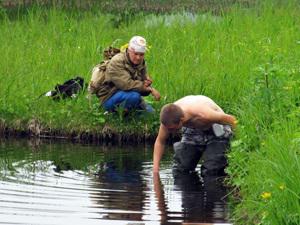Yury O. Kopylov-Guskov
Other projects
2 Mar 2017
In the Footsteps of Georg Steller: Obtaining Information about Endangered Plant Species on the Mednyj Island (Commander Islands, Northern Far East of Russia)
To fill a gap in information about status of insular populations of 6 endangered and 14 North American species that grow in Russia only on the Commander Islands. To use the obtained information to perform better protection of these species, monitoring of the populations and ecological education.

Polina Volkova and Nikita Tikhomirov collecting Isoetes asiatica.
The Commander islands – the northernmost oceanic islands of Russian Far East – represent vulnerable ecosystem. Unique insular biota was formed as a result of contact between biotas of Kamchatka and North America and further shaped by geological history and geographical position of the islands. Many unique insular populations are in poor condition, which is becoming even worse in some cases. The Komandorsky nature reserve was established on the islands in 1993, but greater northern part of the largest Bering Island with settlement Nikolskoe was not included in protected area. Moreover, the nature reserve is focused on fauna protection, which is relatively well-studied and is continued to be intensively monitored. In the same time the insular flora, including vulnerable peripheral populations of plants with North American area and rare species from Red Book of Russia, remains poorly studied.
Several species included in the Red Book of Russia have been reported from the Commander islands: Isoetes maritima; Cypripedium calceolus (rare, was found on the Commander islands only by G. Steller in XVIII century, this finding should be approved), Cypripedium yatabeanum, Isoetes echinospora, Platanthera camtschatica and Cypripedium macranthon. The last three species were only recently discovered on the Commander islands. The islands also serve as western border of area for 14 North American species, being the only locality of vulnerable peripheral populations of these species in Russia (included in Red Book of Kamchatka). Status of the local populations of the above mentioned species that are suffering from antropogenic pressure, is unknown; search for new populations is deserved.
In this project we are going to reveal exact actual status of known populations of these endangered species on the Commander islands and look for new, previously unknown populations in suitable habitats from remote and not yet investigated locations. Moreover, as a number of rare species has been found only recently (in the beginning of XXI century), we expect findings of new rare species. The obtained information on location and status of the populations of the endangered species will be disseminated in various ways. Part of the field studies will be done in collaboration with staff of the nature reserve, increasing their knowledge of the species biology. As a result it would be possible to perform better protection of these species and monitoring of the populations and also ecological education of the community.